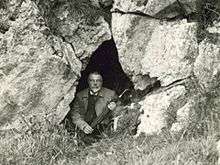Thomas Johnson Westropp

Thomas Johnson Westropp (16 August 1860 – 9 April 1922)[1] was an Irish antiquarian, folklorist and archaeologist.
Career
Westropp was born on 16 August 1860 at Attyflin Park, Patrickswell, County Limerick. His relatives were landowners of English origin and had lived there since the mid 16th century. He displayed an early interest in antiquities, making notes on topography, ancient buildings and folk life whenever his family would make trips into the neighboring counties.
He attended Trinity College at the University of Dublin and graduated in 1882 with an MA. A degree in civil engineering followed in 1885, at which time he was apprenticed to Bindon Blood Stoney, who was engaged in a project to widen and dredge the entrance to the Port of Dublin. After he finished his training, Westropp became the assistant surveyor for County Meath, but soon abandoned his professional work to pursue his archaeological interests. He spent the remainder of his life researching antiquities along the western seaboard.[2][3]
He drew many detailed sketches of buildings, grave slabs and other archaeological remains throughout Ireland. Many of these sketches are held by the Royal Irish Academy. His publications are widely available in libraries throughout the west of Ireland.[4][5]
County Clare
Folklore

_(14593898110).jpg)
While surveying the field monuments of County Clare, he became fascinated by the variety and descriptiveness of the folk tales he heard being recited by the locals. Over the course of several years, he gathered these tales, beliefs and customs and published them in a series of articles which appeared in "Folk-Lore: Transactions of the Folk-Lore Society" between 1910 and 1913. In 2006 these folk-tales were published on the internet by the County Clare Library.[6] Many of these tales have since been lost to living memory. His writings later provided the foundation for the work of the Irish Folklore Commission.
The Normans and prehistoric sites
Westropp also undertook research into the early history of Clare and Limerick (which the Normans called Thomond) and published his finding in three historical essays covering the years 1275-1287, 1287-1313 and 1313-1318, respectively. He then focused on the palaces of early Killaloe, other prehistoric stone-forts and the 'peel towers'or tower houses, eventually publishing several articles about his findings:
- The Promontory Forts and Early Remains of the coasts of County Mayo
- Killaloe and Its Ancient Palaces and Cathedral
- Types of Ring-forts and Similar Structures Remaining in Eastern Clare (the Newmarket Group)
- Prehistoric Stone Forts of Central Clare - Moghane and Langough, near Dromoland
- Notes on the Lesser Castles or 'Peel Towers' of the County of Clare
Books
| Wikisource has original works written by or about: Thomas Johnson Westropp |
- The Ancient Forts of Ireland, Dublin, Printed at the University press, by Ponsonby and Weldrick (1902)
- Kilkee (Co. Clare) and it's Neighbourhood. Printed by Guy and Co 114 O'Connell Street Limerick 1913
- The Antiquities of Limerick and its Neighborhood, Dublin, Hodges, Figgis and co., limited (1916)
- Archaeology of the Burren : Prehistoric Forts and Dolmens in North Clare, Ennis, Co. Clare : Clasp Press (1999). ISBN 1-90054-510-1
- Folklore of Clare : a Folklore Survey of County Clare & County Clare Folk-tales and Myths, with an introduction by Gearóid Ó Crualaoich, Ennis, Co. Clare : Clasp Press (2000) ISBN 1-90054-512-8
- 'Antiquities Near Miltown Malbay', Journal of the Limerick Field Club vol. 2(8), (1904), pp 247-256 and vol. 3(9), (1905), pp 1-15 on the Clare County Library website.
- 'The Augustinian Houses of the County Clare: Clare, Killone, and Inchicronan', Journal of the Royal Society of Antiquaries of Ireland vol. 30 (1900), pp. 118-135 on the Clare County Library website.
- Ring-Forts in the Barony of Moyarta, Co. Clare, and their Legends on the Clare County Library website.
- Prehistoric Stone Forts of Central Clare: Moghane and Langough, near Dromoland on the Clare County Library website.
- Types of the Ring-forts and similar structures remaining in Eastern Clareon the Clare County Library website.
- 'The Churches of County Clare', Proceedings of the Royal Irish Academy, Third Series, Vol. VI, No. 1. October 1900, pp. 100-176 on the Clare County Library website.
- 'Churches with Round Towers in Northern Clare', Journal of the Royal Society of Antiquaries of Ireland, Vol. IV 5th Series, Vol. XXIV Consecutive Series (1894), pp. 25-34, 150-159, 332-340 on the Clare County Library website.
- 'The Earthworks and Castle of Bunratty, Co. Clare', Journal of the North Munster Archaeological Society, Vol. III, No. 4 (1915), pp. 314-327 on the Clare County Library website.
- 'Killaloe: Its Ancient Palaces and Cathedral', Journal of the Royal Society of Antiquaries of Ireland, Vol. XXII (1892), Series V, Vol. II, Part IV, pp 398-410 on the Clare County Library website.
References
- ↑ Obituary Notices. In: Journal of the Royal Society of Antiquaries of Ireland, Sixth Series, Vol. 13, No. 1 (Jun. 30, 1923), pp. 108–110.
- ↑ Journal of the Galway Archaeological and Historical Society (JSTOR) Vol. 51, 1999
- ↑ The Journal of the Royal Society of Antiquities of Ireland, Sixth Series, Vol. 2, No. 3
- ↑ "Full text of "The ancient forts of Ireland: being a contribution towards our knowledge of their types, affinities, and structural features"". Archive.org. Retrieved 2012-04-17.
- ↑ National Library of Ireland:Sources
- ↑ County Clare Folk-Tales and Myths by Thomas Johnson Westropp, at the County Clare Library